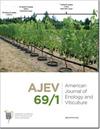南北向垂直种植葡萄园叶片和茎干水势测量的适宜时机
IF 1.8
3区 农林科学
Q3 BIOTECHNOLOGY & APPLIED MICROBIOLOGY
引用次数: 4
摘要
在威拉米特山谷葡萄园中,采用单幕垂直定位(VSP)冠层,对葡萄藤水分状况的日变化以及测量叶水势(LWP)和茎水势(SWP)的合适时间进行了研究。在两年多的开花和收获之间的七个晴朗的日子里,对霞多丽和黑皮诺葡萄藤进行了LWP和SWP的测量。在温暖的日子里,当葡萄藤经历中度水分胁迫(LWP<-1.20 MPa)时,LWP在中午(1300小时)达到每日最小值,并在那里停留更长的时间,而不是轻度水分胁迫(LWP>-1.20兆帕)。然而,在凉爽的日子里,在胁迫和非胁迫的葡萄藤中,LWP在当天晚些时候达到了每日最低值(1400小时至1500小时)。在所有条件下,SWP在当天晚些时候(1400小时至1600小时)达到每日最低水平,甚至在上午晚些时候至中午之间有两次增加。因此,中午测量SWP始终低估了N-S向VSP树冠中葡萄藤所经历的最大水分胁迫水平。这项研究的结果表明,在温暖晴朗的日子里,当葡萄藤经历中等程度的水分胁迫时,可以从中午开始在四个小时内确定LWP:在这种情况下,评估葡萄藤的水分状况以安排灌溉是最关键的。SWP应在1500小时至1700小时之间的两小时内,在N-S定向VSP雨棚中测试的所有条件下进行测量。本文章由计算机程序翻译,如有差异,请以英文原文为准。
Appropriate Time to Measure Leaf and Stem Water Potential in North-South Oriented, Vertically Shoot-Positioned Vineyards
The diurnal changes in vine water status and the appropriate time of day to measure leaf water potential (LWP) and stem water potential (SWP) were examined in Willamette Valley vineyards with north-south (N-S) oriented rows employing a single curtain, vertically shoot-positioned (VSP) canopy. Measurements of LWP and SWP were performed on Chardonnay and Pinot noir grapevines on seven cloudless days between bloom and harvest over two years. On warm days, LWP reached the daily minimum value by midday (1300 hr) and remained there for a longer duration when vines experienced moderate water stress (LWP < -1.20 MPa) than minor water stress (LWP > -1.20 MPa). However, on cool days, LWP reached the daily minimum later in the day (1400 hr to 1500 hr) in both stressed and unstressed vines. SWP reached the daily minimum level late in the day (1400 hr to 1600 hr) under all conditions and even increased between late morning and midday on two occasions. Thus, measuring SWP at midday consistently underestimates the greatest level of water stress experienced by vines in N-S oriented, VSP canopies. Results of this study show that LWP can be determined over a four-hour period starting at midday on warm sunny days when vines experience a moderate level of water stress: conditions when it is most critical to assess vine water status to schedule irrigation. SWP should be measured in the two-hour period between 1500 hr and 1700 hr under all conditions tested here in N-S oriented, VSP canopies.
求助全文
通过发布文献求助,成功后即可免费获取论文全文。
去求助
来源期刊

American Journal of Enology and Viticulture
农林科学-生物工程与应用微生物
CiteScore
3.80
自引率
10.50%
发文量
27
审稿时长
12-24 weeks
期刊介绍:
The American Journal of Enology and Viticulture (AJEV), published quarterly, is an official journal of the American Society for Enology and Viticulture (ASEV) and is the premier journal in the English language dedicated to scientific research on winemaking and grapegrowing. AJEV publishes full-length research papers, literature reviews, research notes, and technical briefs on various aspects of enology and viticulture, including wine chemistry, sensory science, process engineering, wine quality assessments, microbiology, methods development, plant pathogenesis, diseases and pests of grape, rootstock and clonal evaluation, effect of field practices, and grape genetics and breeding. All papers are peer reviewed, and authorship of papers is not limited to members of ASEV. The science editor, along with the viticulture, enology, and associate editors, are drawn from academic and research institutions worldwide and guide the content of the Journal.
 求助内容:
求助内容: 应助结果提醒方式:
应助结果提醒方式:


